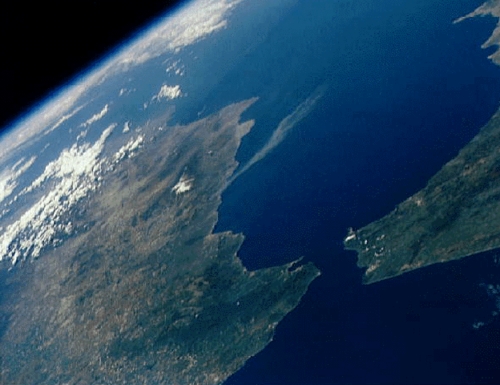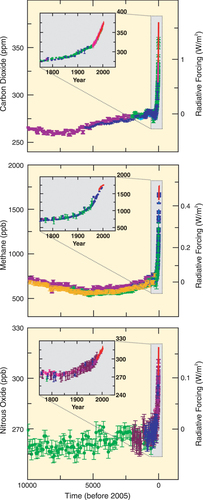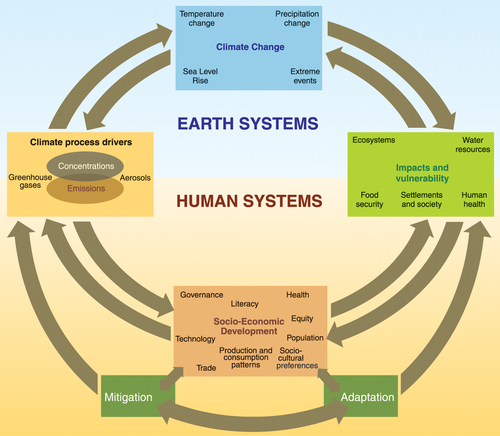Handling editor: Evelyn Sander
Climate Math in San Diego
Mary Lou Zeeman, Chair, SIAG/DS

Earth and its atmosphere. The atmosphere is just visible as the thin blue shell around the earth. From http://pds.jpl.nasa.gov/planets/welcome/earth.htm
It is a pleasure for me to serve as the new chair
of SIAG/DS. Our activity group, journal and web portal are healthy, we
have an active, forward looking group of officers, and our program
directors already have the plans for Snowbird 2009 well under
way.
My own research has been primarily on searching for
relationships between the geometry, algebra, and dynamics in models of competing
species and on rhythms in our neuroendocrine axes, particularly in the
menstrual cycle. The research and teaching collaborations I have
established with biologists, environmental scientists and computer
scientists have been extremely enriching for me, and have shown me the
power and breadth of dynamical systems as an intellectual framework
for addressing problems in the applied and social sciences. This
experience, and the data, are what drive my conviction that we offer a
wealth of largely untapped resources for addressing problems related
to the state of our planet.
The climate science community is already very
mathematical, and open to joint conferences and collaboration with
mathematicians. At the Climate Math sessions of the Joint Math
Meetings (JMM) in San Diego in January, we had a four day program of
lectures and discussions featuring climate scientists, mathematicians,
economists and California Congressman Jerry McNerney. See the recent
articles describing the sessions by Pat Kenschaft [1,2], and the
lecture notes from the talks posted at [3,4, and 5]. In particular, we
had a productive audience discussion focused on how we can
empower our community to help tackle the mathematical challenges in
climate research, so I would like to share some of those
ideas here.
Mathematical Opportunities
A group of us at Cornell teach a class called the
State of the Planet [6], where our theme is "Whatever your talent,
whatever your passion, you can use them to help the planet."
|
It's a
powerful philosophy - giving each of us the liberty to figure out how
to focus the type of math we enjoy on problems that we care
about. Climate change research is full of mathematical challenges,
ranging from process modeling with continuous and stochastic dynamical systems, to inverse
problems, data assimilation, efficient numerical methods, quantifying
uncertainty in models of inherently chaotic systems, integrating climate and economics models to address “what if” questions, and more. For more detail, see the white paper
by Dana McKenzie [7] resulting from the first MSRI Climate Change workshop
in April 2007, [8], the “Short Introduction” to the consequences of chaos for weather and climate prediction by Leonard Smith [9], and the 2007 Assessment Report of the
Intergovernmental Panel on Climate Change (IPCC) [10] for an
up-to-date objective summary of the Climate Change literature and
associated data.
Global sustainability and resource management
questions from fisheries and forests to energy and carbon emissions
raise new classes of problems at the interface of mathematics,
economics and computer science, in which a dynamical system modeling the resource is perturbed at discrete points in time by optimization based policy or
management decisions. How do we classify the behavior of such systems?
|
|
 |
| 1000 year observed changes in atmospheric greenhouse gas concentrations from ice core and modern data. Measurements are shown from ice cores (symbols with different colors for different studies) and atmospheric samples (red lines). From IPCC, AR4, WG1, SPM, 2007. |
The classic tragedy of the commons problem can be viewed as a game
theoretic but also multi-scale problem, as it lies in the tension
between the short- and long-term effects of our behavior. Spread of
disease and ecosystem preservation both take on new dynamic spatial
components as species move poleward in response to warming
habitats. The concept of tipping point that has emerged in the popular
press in the context of polar ice melting, ocean circulation,
fisheries and more is completely natural to us as a bifurcation, and
begs our attention. Another way to learn more about questions that could use your skills is to explore an interface journal such as Natural Resource Modeling [11]. The 1997 AAAS Presidential Address by Jane Lubchenco [12] is also both informative and inspiring.
Bridging Communitees
|
To collaborate with colleagues in another
discipline, we need to learn enough of each other's language to be
able to understand the subtleties our colleagues are explaining to
us. In the interface between dynamical systems and biology, it becomes
most exciting when the mathematician knows enough about how the data
is collected to be able to suggest precise experiments to distinguish
between models, or when the biologist can point to a surprising jump
in the data, and suggest we analyze the bifurcation. As a community,
we don't yet know the language of climate change research. Given the
importance of the problems, the mathematical richness they contain,
our potential to help, and the motivating power of the subject, let's
work with SIAM and SIAG/DS to create an active learning community and
accelerate the process.
|
|
 |
| 150 year observed changes in global mean temperature, sea level and snow cover. All differences are relative to corresponding averages for the period 1961-1990. Smoothed curves represent decadal averaged values while circles show yearly values. From IPCC, AR4, WG1, SPM, 2007. |
Conferences.
If you are coming to a conference (e.g. Snowbird,
the SIAM annual conference, or the JMM) look for the minisymposia and
workshops on Environmental and Climate Math. It's an easy way to get a
glimpse at the field, and the people in it. Also keep your eyes on the
math institutes and the funding agencies, as they embrace this
area. For example, there is a Climate Change Summer School at MSRI [13] this summer, and more planned for the future. If
you already know a Climate Math question that interests you, please
run a minisymposium at any conference you think would have a promising
audience. Your minisymposium might have the traditional goal of
highlighting what has been achieved, or the less traditional but
equally important goal of highlighting the open problems. It helps to
choose an interdisciplinary team of organizers, to mix mathematician
and experimentalist speakers, and to think creatively about how to
stimulate cross-disciplinary discussion among the audience. Note that
to bring a speaker to a conference outside their own discipline, you
may need to help cover their expenses. The NSF Division of
Mathematical Sciences (DMS) welcomes proposals for conferences, either
through its disciplinary programs [14] or through
its Special Meetings program [15]. Proposals need
to be submitted through the Office of Sponsored Research (or its
equivalent) at your university; instructions can be found in the 2008
NSF Grant Proposal Guide [16]. In general, it is a
good idea to contact the program officer to discuss what are
"allowable" expenses; helpful guidelines for conference proposals
submitted to DMS are available upon request from Dr. Hans G. Kaper [17]

Anthropogenic climate change drivers, impacts and responses. From IPCC AR4, SYR, 2007.
Publications
Can you write a survey article that would explain
an open problem in climate or sustainability research to the dynamical
systems or broader math community? If you can't do it alone, could you
do it in collaboration with a colleague who knows the question but not
our language? Please do! Articles of this nature would really help, whether they
be at the level of SIADS, SIAM News, DSWeb Magazine or another
appropriate target audience.
Climate Math Website
We are hoping to develop web materials, over the
next year or two, designed to introduce mathematicians to climate and
sustainability research. Suggestions for the site from the JMM
discussion included: 1) a summary of open problems; 2) descriptions of
climate models of simple and intermediate complexity, together with
matlab code for experimentation with the models; 3) links to survey articles; 4) annotated reading
lists focused on particular physical processes or problems; 5) an
introduction to the archive of IPCC model output and 6) educational
materials for bringing into the classroom at a variety of levels. If
you have ideas or materials the site, or would like to help with site
development, please let me know [18].
Education
If you have taught a course that included a
component on mathematics and sustainability, please share your
experience with DSWeb Magazine readers. What worked, and what didn't?
For example, if you organized a reading course on climate modeling,
what did you read? What resources gave you most insight? If you
brought a sustainability theme to your calculus or modeling class,
what data are you using? Do you have problem sets on the web that
others could use? Can you recommend a textbook for a new course, or
papers or book chapters that fit neatly into existing courses in the
math curriculum? The October 2008 issue of DSWeb Magazine will include
a follow up to this article incorporating your contributions. Send
ideas, comments, links and suggestions to DSWeb Magazine Section Chief
Editor, Evelyn Sander, at [email protected] by September 15,
2008.
We welcome other suggestions, and look forward to
hearing from you!
Mary Lou Zeeman currently splits her time between
Bowdoin College, where she is the R. Wells Johnson Professor of
Mathematics, and Cornell University, where she is a Visiting Professor
of Neurobiology and Behavior.
References
| [1] |
|
Pat Kenschaft, "Mathematicians recruited for Climate Change Research," MAA Focus 28 (March 2008) pp14.
|
| [2] |
Pat Kenschaft, "Climate Change: a Research Opportunity for Mathematics?" Notices of the AMS, to appear.
|
| [3] |
Lecture Notes of AMS-SIAM Special Session on Environmental Mathematics at the 2008 Joint Math Meetings in San Diego..
|
| [4] |
Inez Fung, Lecture Notes of the SIAM Invited Lecture at the Joint Math Meetings in San Diego.
|
| [5] |
Lecture Notes of the SIAM minisymposia on Climate Math at the Joint math Meetings in San Diego.
|
| [6] |
Krystal L. Rypien et al., "Students unite to create State of the Planet course," Nature 445 (June 2007) pp775.
|
| [7] |
D. McKenzie, Mathematics of Climate Change, Mathematical Sciences Research Institute, Berkeley, CA, 2007.
Link to the PDF of the white paper.
|
| [8] |
MSRI Symposium on Climate Change: From Global Models to Local Action, April 2007
|
| [9] |
Leonard Smith, CHAOS: A Very Short Introduction, Oxford University Press, 2007.
|
| [10] |
"IPCC Fourth Assessment Report," Intergovernmental Panel of
Climate Change, Geneva, Switzerland, 2007. Website linking to
the report. |
| [11] |
Natural Resource Modeling, Blackwell Publishing.
|
| [12] |
Jane Lubchenco, "Entering the Century of the Environment: A New Social Contract for Science," Science, 279 (Jan 1998).
|
| [13] |
Climate Change Summer School, Mathematical Sciences Research Institute, Berkeley, CA, July 14-August 1, 2008.
Workshop website.
|
| [14] |
National Science Foundation, Division of Mathematical Sciences,
Disciplinary Programs.
|
| [15] |
National Science Foundation, Division of Mathematical Sciences,
Special Meetings Program.
|
| [16] |
National Science Foundation, Division of Mathematical Sciences,
Grant Proposal Guide.
|
| [17] |
Hans Kaper, National Science Foundation, Email: [email protected] .
|
| [18] |
Mary Lou Zeeman, Bowdoin College, Email: [email protected] .
|